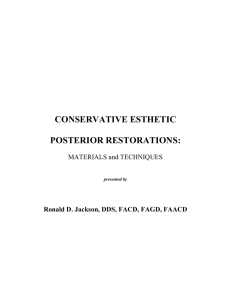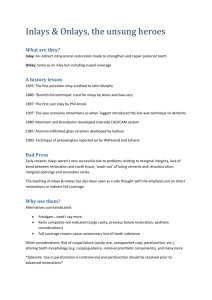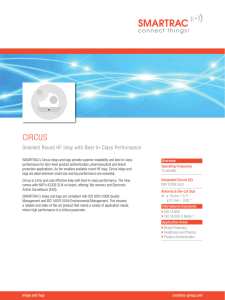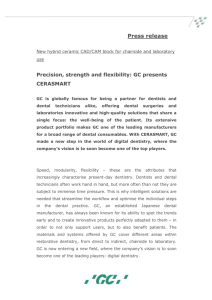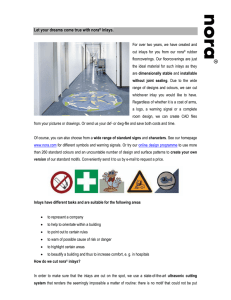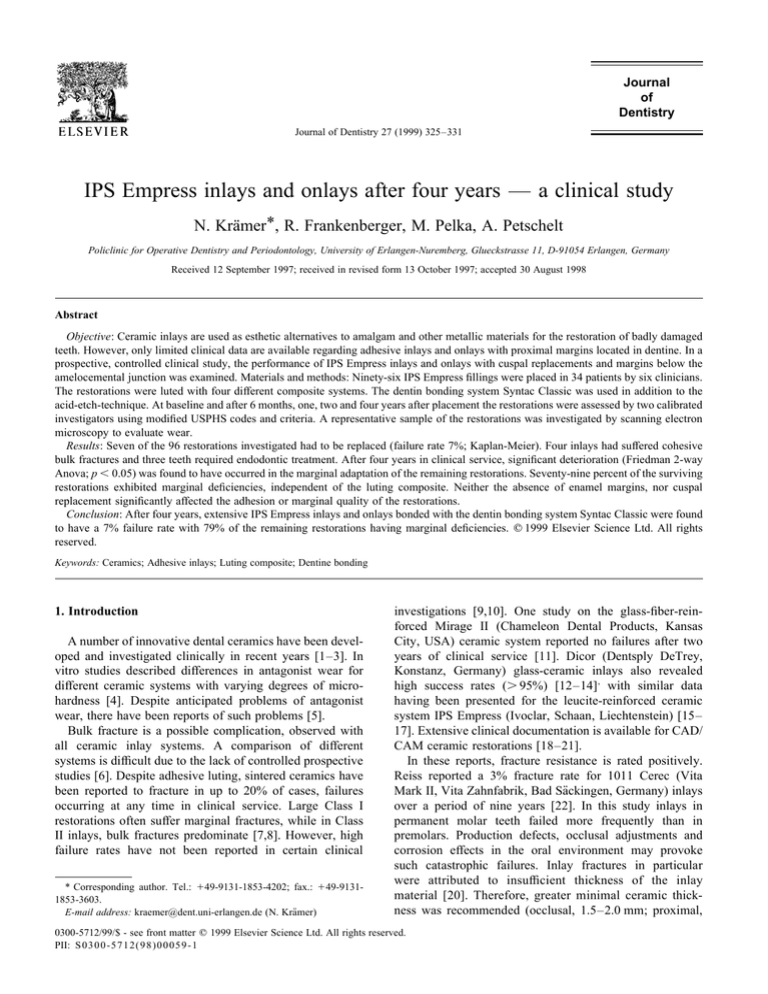
Journal
of
Dentistry
Journal of Dentistry 27 (1999) 325–331
IPS Empress inlays and onlays after four years — a clinical study
N. Krämer*, R. Frankenberger, M. Pelka, A. Petschelt
Policlinic for Operative Dentistry and Periodontology, University of Erlangen-Nuremberg, Glueckstrasse 11, D-91054 Erlangen, Germany
Received 12 September 1997; received in revised form 13 October 1997; accepted 30 August 1998
Abstract
Objective: Ceramic inlays are used as esthetic alternatives to amalgam and other metallic materials for the restoration of badly damaged
teeth. However, only limited clinical data are available regarding adhesive inlays and onlays with proximal margins located in dentine. In a
prospective, controlled clinical study, the performance of IPS Empress inlays and onlays with cuspal replacements and margins below the
amelocemental junction was examined. Materials and methods: Ninety-six IPS Empress fillings were placed in 34 patients by six clinicians.
The restorations were luted with four different composite systems. The dentin bonding system Syntac Classic was used in addition to the
acid-etch-technique. At baseline and after 6 months, one, two and four years after placement the restorations were assessed by two calibrated
investigators using modified USPHS codes and criteria. A representative sample of the restorations was investigated by scanning electron
microscopy to evaluate wear.
Results: Seven of the 96 restorations investigated had to be replaced (failure rate 7%; Kaplan-Meier). Four inlays had suffered cohesive
bulk fractures and three teeth required endodontic treatment. After four years in clinical service, significant deterioration (Friedman 2-way
Anova; p ⬍ 0.05) was found to have occurred in the marginal adaptation of the remaining restorations. Seventy-nine percent of the surviving
restorations exhibited marginal deficiencies, independent of the luting composite. Neither the absence of enamel margins, nor cuspal
replacement significantly affected the adhesion or marginal quality of the restorations.
Conclusion: After four years, extensive IPS Empress inlays and onlays bonded with the dentin bonding system Syntac Classic were found
to have a 7% failure rate with 79% of the remaining restorations having marginal deficiencies. 䉷 1999 Elsevier Science Ltd. All rights
reserved.
Keywords: Ceramics; Adhesive inlays; Luting composite; Dentine bonding
1. Introduction
A number of innovative dental ceramics have been developed and investigated clinically in recent years [1–3]. In
vitro studies described differences in antagonist wear for
different ceramic systems with varying degrees of microhardness [4]. Despite anticipated problems of antagonist
wear, there have been reports of such problems [5].
Bulk fracture is a possible complication, observed with
all ceramic inlay systems. A comparison of different
systems is difficult due to the lack of controlled prospective
studies [6]. Despite adhesive luting, sintered ceramics have
been reported to fracture in up to 20% of cases, failures
occurring at any time in clinical service. Large Class I
restorations often suffer marginal fractures, while in Class
II inlays, bulk fractures predominate [7,8]. However, high
failure rates have not been reported in certain clinical
* Corresponding author. Tel.: ⫹49-9131-1853-4202; fax.: ⫹49-91311853-3603.
E-mail address: kraemer@dent.uni-erlangen.de (N. Krämer)
investigations [9,10]. One study on the glass-fiber-reinforced Mirage II (Chameleon Dental Products, Kansas
City, USA) ceramic system reported no failures after two
years of clinical service [11]. Dicor (Dentsply DeTrey,
Konstanz, Germany) glass-ceramic inlays also revealed
high success rates (⬎ 95%) [12–14] , with similar data
having been presented for the leucite-reinforced ceramic
system IPS Empress (Ivoclar, Schaan, Liechtenstein) [15–
17]. Extensive clinical documentation is available for CAD/
CAM ceramic restorations [18–21].
In these reports, fracture resistance is rated positively.
Reiss reported a 3% fracture rate for 1011 Cerec (Vita
Mark II, Vita Zahnfabrik, Bad Säckingen, Germany) inlays
over a period of nine years [22]. In this study inlays in
permanent molar teeth failed more frequently than in
premolars. Production defects, occlusal adjustments and
corrosion effects in the oral environment may provoke
such catastrophic failures. Inlay fractures in particular
were attributed to insufficient thickness of the inlay
material [20]. Therefore, greater minimal ceramic thickness was recommended (occlusal, 1.5–2.0 mm; proximal,
0300-5712/99/$ - see front matter 䉷 1999 Elsevier Science Ltd. All rights reserved.
PII: S0300-571 2(98)00059-1
326
N. Krämer et al. / Journal of Dentistry 27 (1999) 325–331
Table 1
Features of the restorations investigated
Surface roughness
Colour matching
Anatomic form
Anatomic form (margin)
Marginal integrity
Integrity tooth
Integrity inlay
Proximal contact
Changes in sensitivity
Complaints
Radiographic check
Subjective contentment
0.8–1.5 mm) [23]. This requires an aggressive approach to
preparation, which is often difficult to justify clinically [16].
Walther calculated a Kaplan-Meier survival analysis of 95%
after 5 years, which is representative of other clinical studies
of Cerec restorations [19,20,22]. All clinical investigations
of ceramic inlays reveal appreciable changes in the marginal
areas of the restorations [7,8,11,18]. Marginal integrity and
fracture rates are conspiciously related to the mode of placement [8,9]. Furthermore, the luting system may be crucial to
achieve success with ceramic inlays.
The purpose of the present prospective clinical study was
to evaluate the performance of adhesively luted, extensive
IPS Empress inlays and onlays with margins partially
located below the amelocemental junction.
2. Materials and methods
Patients were selected for this study according to the
following criteria:
1. Absence of pain from the tooth to be restored
2. Application of rubber dam possible
3. Proximal margins located below the amelocemental
junction in 50% of cases
4. No further restorations planned in other posterior tooth
5. High level of oral hygiene
6. Absence of any active periodontal and pulpal diesease.
All patients were treated in the Policlinic for Operative
Dentistry and Periodontology, University of ErlangenNuremberg, by six different clinicians (research assistants)
who had experience with ceramic inlays and onlays. All
patients were required to give written informed consent.
The study was conducted according to EN 540 (Clinical
investigation of medical devices for human subjects,
European Committee for Standardization). The patients
agreed to a recall programme of four years consisting of
one appointment per year.
The preparations for the restorations were performed
without bevelling of the margins using 80 mm diamond
burs (Inlay Prep-Set, Intensiv, Viganello-Lugano, Switzerland), and finished using 25 mm finishing diamonds. The
minimum depth was 1.5 mm with the occluso-axial angles
being rounded. Dentine close to the pulp was covered with a
calcium hydroxide cement (Calxyl, OCO-Praeparate
GmBH, Dirmstein, Germany). A glass ionomer cement
(Ketac Bond䉸, Espe, Seefeld, Germany) was used as the
lining material.
Full-arch impressions were taken with a polyvinyl-siloxane material (Permagum High Viscosity, Espe, Seefeld,
Germany), using low-viscosity material (Permagum Garant,
Espe) in syringes to record preparation details.
One dental ceramist produced all the inlays and onlays
according to manufacturers instructions.
The intraoral fit was evaluated under rubber dam and
internal adjustments performed using finishing diamonds.
Interproximal contacts were assessed using waxed dental
floss and contact gauges (YS Contact Gauge, YDMYamaura, Tokyo, Japan). Prior to insertion, the thickness
of the inlays and onlays was measured using a pair of tactile
compasses
(Schnelltaster,
Kroeplin,
Schluechtern,
Germany) with an accuracy of 0.01 mm: The minimum
thickness between deepest fissure and fitting surface,
minimal width in the isthmus region for inlays, and the
minimum thickness of the cuspal coverage in onlays were
recorded.
The restorations were luted adhesively using the enamel
etch technique under rubber dam. The enamel margins were
cleaned with pumice slurry and etched with 37% phosphoric
acid gel. The dentin adhesive Syntac Classic (Vivadent) was
then applied. The internal surface of the ceramic inlays was
etched with 4.5% hydrofluoric acid (IPS Ceramic etching
gel, Vivadent, Schaan, Liechtenstein) and then silanated
with Monobond S (Vivadent).
Adhesive insertion was performed with four different
luting composites: Dual Cement (n 9), Variolink Low
(n 32), Variolink Ultra (n 6), and Tetric (n 49) (all
Vivadent, Schaan, Liechtenstein). The composite resins
with high viscosity (Variolink Ultra, Tetric) were used
according to the USI-technique (ultrasonic insertion/EMS
Piezon Master 400, Le Sentier, Switzerland) [24]. Polymerization of the luting agents was performed by light-curing
for 120 s from different positions (40 s in each direction).
Prior to polymerization, the luting composite was covered
with glycerine gel to prevent the formation of an oxygeninhibited layer.
After light-curing, the rubber dam was removed. Occlusal
contacts in centric and eccentric positions were adjusted
with diamond finishing burs (Intensiv, Viganello-Lugano,
Switzerland), followed by Sof-Lex discs (3M, St. Paul,
MN, USA). Overhangs were removed and polished in the
same way, proximally with interdental diamond strips (GC
Dental Industrial Corp, Tokyo, Japan) and interdental
polishing strips (3M, St. Paul, MN, USA). Final polishing
was conducted using felt discs (Dia-Finish E Filzscheiben,
Renfert, Hilzingen, Germany) with polishing gel (Brinell,
Renfert, Hilzingen, Germany).
Following placement of a restoration, the restored tooth
N. Krämer et al. / Journal of Dentistry 27 (1999) 325–331
3. Results
Table 2
Modified USPHS criteria
Modified
criteria
Description
Analogous
USPHS
criteria
“excellent”
“good”
perfect
slight deviations from ideal
performance, correction possible
without damage of tooth or restoration
few defects, correction impossible
without damage of tooth or
restoration. No negative effects
expected
severe defects, prophylactic removal
for prevention of severe failures
immediate replacement necessary
“alpha”
“sufficient”
“insufficient”
“poor”
327
“bravo”
“charlie”
“delta”
was covered with a fluoride solution for 60 s (Elmex Fluid,
Wybert, Lörrach, Germany).
At initial recall (baseline) and after one, two and four
years, all restorations were assessed according to modified
United States Public Health Service (USPHS) criteria
(Tables 1 and 2) by two independent investigators using
mirrors, probes, bitewing radiographs, and intraoral photographs [24]. Recall assessments were not performed by the
clinician who had placed the restorations.
Clinical changes relating to the different luting composites were evaluated as part of the assessment of marginal
integrity.
The statistic analysis was undertaken with SPSS for
Windows 95/V7.0. The statistic unit was one ceramic
restoration, differences between the groups were evaluated
pair-wise with the Mann-Whitney test (level of significance.05).
A representative sample of the restorations was investigated using scanning electron microscopy (SEM).
Epoxy replicas (Epoxy-Die, Ivoclar, Schaan, Liechtenstein) were sputtered with gold (Balzers SCD 40, Balzers,
Liechtenstein) and viewed under SEM (Leitz ISI 50,
Akashi, Tokyo, Japan) at X200 magnification.
Ninety six inlays (F2: n 45; F3: n 27) and onlays (n
24) were placed in 34 patients (11 male, 23 female; age 20–
57 years, mean 33 years). Thirty percent of the restorations
were placed (n 29) in maxillary molars, 23% (n 22) in
maxillary premolars, 29% (n 28) in mandibular molars,
and 18% (n 17) in mandibular premolars.
The recall rate after an average of 3.97 years was 100%.
The majority (96%) of the patients were satisfied with their
restorations. One patient was disatisfied due to marginal
fracture of one restoration. Seven restorations could not be
examined after 48 months due to failure. Over the observation period, the other 85 investigated restorations revealed
no statistically significant differences as regards: surface
roughness, colour matching, anatomic form, anatomic
form (margin), proximal contact, sensitivity, complaints,
radiographic check and subjective contentment (Table 3).
Drawing a comparison between the data collected at the
four-recall appointments, significant differences were found
in relation to marginal integrity. The rating “excellent”
dropped from 39% at baseline to 7% after four years. The
main reason for the assessment “good” was initially
“composite overhang” and over time “wear of the luting
cement” (“ditching”) and discolouration. No statistically
significant differences were attributable to the different
luting systems (p ⬍ .05, Mann-Whitney test). In one case,
a gap formation (adhesive failure between enamel and
luting composite) was detected following a cusp fracture.
Clinically, the absence of enamel in the apical sections of
proximal boxes did not have any influence on marginal
performance of the inlays and onlays.
A significant difference was detected between the baseline and the four-year recall data in relation to tooth integrity. After four years, 40% of the restored teeth included
small enamel cracks — an increase of 28% from the time
of insertion of the restorations. Twelve percent of the
restored teeth revealed enamel crack formation already
after insertion of the restoration.
The incidence of inlay fracture over time increased from
4% at baseline to 19% after 4 years. Chipping in the
Table 3
Results of the clinical investigation (1 excellent, 2 good, 3 sufficient)
Investigation [assessed cases]
Baseline [89]
1 year [96]
2 years [95]
4 years [89]
Date of investigation (S.D.)
Surface
Colour matching
Anatomic form
Anatomic form (margin)
Proximal contact
Changes in sensitivity
Complaints
Radiographic check
Subjective contentment
0.5 years (0.14)
1:92, 2:8
1:84, 2:16
1:66, 2:34
1:43, 2:57
1:85, 2:15
1:94, 2:6
1:87, 2:13
—
1:100
1.1 years (0.16)
1:41, 2:59
1:59, 2:39, 3:2
1:77, 2:23
1:15, 2:85
1:87, 2:13
1:94, 2:6
1:90, 2:6, 3:4
—
1:100
2.1 years (0.17)
1:41, 2:59
1:66, 2:33, 3:1
1:74, 2:25, 3:1
1:11, 2:88, 3:1
1:84, 2:10, 3:6
1:100
1:98, 2:2
1:88, 2:11, 3:1
1:99, 3:1
4.0 years (0.14)
1:45, 2:55
1:75, 2:23, 3:1
1:53, 2:47
1:5, 2:94, 3:1
1:88, 2:11, 3:1
1:100
1:100
1:92, 2:5, 3:3
1:96, 3:4
328
N. Krämer et al. / Journal of Dentistry 27 (1999) 325–331
Fig. 1. Survival analysis (Kaplan-Meier algorithm).
occlusal-proximal contact area was observed. Comparisons
of clinical photographs revealed that these fractures
occurred in the areas of occlusal adjustments.
After the 4-year recall, two inlays had to be replaced due
to bulk fracture. The survival rate computed with the
Kaplan-Meier algorithm was 93% after 4 years (Fig. 1).
Three inlays had to be removed due to complaints (two
because of hypersensitivity, one after endodontic treatment
prior to the start of the study). Fracture of the ceramic
material led to replacement of six inlays. The initial clinical
fractures were observed after 3 years.
The average dimensions recorded prior to insertion were
1.4 mm below the deepest fissure, 3.5 mm at the isthmus,
and 2.0 mm below the reconstructed cusps in the onlays.
There was no statistically significant correlation between
dimensions of the inlay and fracture (p ⬎ 0.05).
The SEM evaluation revealed distinct changes in the
luting gap, namely abrasion of the luting composite with
Fig. 2. Contact-free area (CFA) of a IPS Empress inlay with perfect
adaptation in tooth 24 at baseline. The enamel (E), ceramic (C) and luting
composite (L) are visible.
Fig. 3. Characteristic “ditching” attributed to three-body wear in the inlay
illustrated in Fig. 2 after 4 years of clinical service (E enamel, C ceramic, L
luting composite).
progressive ditching in the contact free areas (CFA, Figs.
2 and 3). Changes in the ceramic and enamel marginal areas
were only observed in occlusal contact areas (OCA, Figs. 4
and 5). In all cases, ceramic, enamel, and luting composite
were abraded to the same extent.
Fig. 4. Occlusal contact area (OCA) of a IPS Empress inlay in tooth 35 at
baseline.
N. Krämer et al. / Journal of Dentistry 27 (1999) 325–331
Fig. 5. Tooth 35 of Fig. 4 after 4 years: In the marked area (circle) ceramic
(C), luting composite (L) and enamel (E) abraded similarly.
4. Discussion
The present study investigated the 4-year performance of
adhesively luted IPS Empress ceramic inlays and onlays.
Particular attention was directed to restorations with proximal margins located in dentine.
The modified USPHS criteria [25] employed proved to be
reliable for the tooth-coloured restorations as previously
reported by Pelka et al. [26].
Patient complaints diminished during the course of the
study. Hypersensitivity was observed in 13% of the cases at
baseline, but reduced rapidly thereafter. Especially in the
adhesive inlay technique, postoperative hypersensitivity is
a major problem for the clinician due to incomplete sealing
of the dentine or detachment between lining material and
dentine [27]. To solve this problem, the use of dentine adhesives and luting composites is recommended. In the present
study, the dentine adhesive system Syntac Classic was used
with different luting composites of the same manufacturer.
In comparison with previous studies, the present results
revealed limited hypersensitivity over the observation
period, independent of the composite resin used for the
luting process [27]. After 1 year one patient (with four
inlays) reported occasional complaints (clinically “sufficient”). During the observation period two inlays had to
be replaced due to severe pulpal pain.
To date, numerous clinical studies have assessed the
luting interface of composite and ceramic inlay systems.
However, most of the documented restorations were luted
with low viscosity composite resins [18,28–30]. The wear
resistance of luting composites was estimated sceptically,
329
irrespective of the inlay material [31,32]. Jäger published a
5-year report, pointing out the high material loss inside the
luting gap and concluded a certain danger for sintered
ceramic restorations, because of their low fracture resistance
in marginal areas [33]. Considerable expectations had been
placed on improvements in luting composites and their wear
behaviour [34]. Nevertheless, the clinical data of the present
study fall short of these expectations concerning the wear
behaviour of higher filled luting composites. In the criterion
“marginal integrity” there was no clinically noticeable
difference between the luting agents used. The predominant
ratings “good” and “sufficient” after 4 years were due to
attrition of the luting composite with the characteristic
ditching. Such gaps between inlay and tooth substrate
were detectable in all groups, independent of the luting
material’s consistency. The favourable clinical rating of
the highly viscous luting composites at baseline was not
confirmed after four years of clinical service [35]. However,
clinical evaluations insufficiently accurate to detect differences in the luting space. A previous study showed that wear
of the luting composite with characteristic ditching occurred
only in the CFA. This was explained by three-body wear
[36] (Figs. 2 and 3).
As in most of the previous studies, the present investigation only described qualitative changes. SEM evaluation
showed marginal ditching independent of the luting composite used. Consequently, results of other SEM investigations
were confirmed [5,8,11], whereas only few quantitative data
on exact volume loss within the luting space of toothcoloured inlays are available [18,37–39].
Another reason for failure of adhesive restorations is an
insufficient adhesive bond between restorative material and
tooth substrate. Recent clinical studies reveal frequent
marginal fractures of ceramic inlays luted with glass ionomer cements [9,40]. In the present study, marginal fractures
were not observed. The uncompromising treatment of the
internal ceramic surface (etching and silanating) apparently
produced minimal material loss and reduced microcracks.
Therefore, only relatively small changes were observed with
this material [8,27].
Another critical point seems to be the bonding of adhesive inlays to dentine. Warnings against bonding to cervical
dentine are well documented [41]. In the present study, 30%
of the inlays had proximal margins located in dentine. None
of these restorations revealed lower clinical ratings or
significant findings, such as secondary caries radiographically.
A further argument in favour of dentine adhesives is the
estimation of some authors that the use of these systems
prevents fractures of the ceramic in bulk or along margins.
Increasing the area of adhesion may enhance the stability of
the ceramic [8].
Significant differences were detected on the adjacent
enamel texture, but these tooth fractures did not have any
significance on the clinical survival behaviour of the restorations. About 18% of the enamel cracks (integrity tooth
330
N. Krämer et al. / Journal of Dentistry 27 (1999) 325–331
“good”) were already detected at baseline. At 4 years, this
observation increased to 40%. Only in isolated cases (⬃ 5%)
were enamel cracks visible. However, no restoration had to
be replaced due to these crack formations.
“Half-moon” fractures in the restorations were detected
as early as 2 years in the criterion “integrity inlay”. These
fractures were observed exclusively in occlusally loaded
marginal ridges with fairly extreme convexities in the direction of the approximating tooth. Analysis of the clinical
photographs indicated that in each case of catastrophic
failure, occlusal corrections had been performed using
rotary instruments. This trend continued throughout the
study. To date, six inlays have failed for this reason. In
two cases, bruxism was considered to be associated with
the fractures.
A correlation between material thickness or cusp reconstruction and ceramic fractures was not evident. The lowest
cusp thickness was 0.3 mm without any consequences.
There is much indication that the fractures occurred due to
fatigue mechanisms. Microcracks produced by occlusal
corrections may not be polished sufficiently, because of
the unfavourable intraoral situation. Graf et al. reported of
considerably decreased flexural fatigue limits of dental ceramics after simulating occlusal corrections [42]. Combined
with occlusal stress during clinical service, the probability
of ceramic fractures seems to be increased. However, the
total failure rate is comparable to that noted in other clinical
trials [15–17]. Nevertheless, an accurate polish of occlusally adjusted areas should arouse considerable attention
to prevent this problem.
[4]
[5]
[6]
[7]
[8]
[9]
[10]
[11]
[12]
[13]
[14]
[15]
[16]
[17]
5. Conclusions
IPS Empress restorations revealed a 7% failure rate with
79% of the remaining restorations having marginal deficiencies after four years.
The evaluated restorative system achieved satisfactory
results for the restoration of larger defects also in the
molar regions. Neither cusp reconstruction nor preparation
margins below the amelocemental junction were limiting
factors for clinical success.
[18]
[19]
[20]
[21]
Acknowledgements
The authors thank Vivadent-Ivoclar for supporting this
study.
References
[1] Kelly JR, Nishimura I, Campbell SD. Ceramics in dentistry: Historical roots and current persepectives. Journal of Prosthetic Dentistry
1996;75:18–32.
[2] Qualthrough AJE, Piddock V. Ceramics update. Journal of Dentistry
1997;25:91–95.
[3] Thonemann B, Federlin M, Schmalz A, Schams A. Clinical
[22]
[23]
[24]
[25]
[26]
evaluation of heat-pressed glass-ceramic inlays in vivo: 2-year results.
Clinical Oral Investigations 1997;1:27–34.
Hudson JD, Goldstein GR, Georgescu M. Enamel wear caused by
three different restorative materials. Journal of Prosthetic Dentistry
1995;74:647–654.
Gladys S, van Meerbeek B, Inikoshi S, Willems G, Braem M,
Lambrechts P, Vanherle G. Clinical and semiquantitative marginal
analysis of four tooth-coloured inlay systems at 3 years. Journal of
Dentistry 1995;23:329–338.
Walther W, Reiss B, Toutenburg H. Longitudinal event analysis of
Cerec inlays. Deutsche Zahnärztliche Zeitschrift 1994;49:914–917.
Molin K, Karlsson SA. A 3-year clinical follow-up study of a ceramic
(Optec) inlay system. Acta Odontologica Scandinavica 1996;54:145–
149.
Qualtrough AJE, Wilson NHF. A 3-year clinical evaluation of a
porcelain inlay system. Journal of Dentistry 1996;24:317–323.
Höglund ÄC, van Dijken JWV, Olofsson AL. Three-year comparison
of fired ceramic inlays cemented with composite resin or glass ionomer cement. Acta Odontologica Scandinavica 1994;52:140–147.
Thordrup M, Isidor F, Hörsted-Bindslev P. A one-year clinical study
of indirect and direct composite and ceramic inlays. Scandinavian
Journal of Dental Research 1994;102:186–192.
Friedl K-H, Schmalz G, Hiller K-A, Saller A. In-vivo evaluation of a
feldspathic ceramic system: 2-year results. Journal of Dentistry
1996;24:25–31.
Bessing C, Molin M. An in vivo study of glass-ceramic (Dicor) inlays.
Acta Odontologica Scandinavica 1990;48:351–358.
Stenberg R, Matsson L. Clinical evaluation of glass-ceramic inlays
(Dicor). Acta Odontologica Scandinava 1993;51:91–97.
Roulet J-F. Longevity of glass-ceramic inlays and amalgam - results
up to 6 years. Clinical Oral Investigations 1997;1:40–46.
Krejci I, Krejci D, Lutz F. Clinical evaluation of a new pressed glassceramic inlay material over 1.5 years. Quintessence International
1992;23:181–186.
Reinelt C, Krämer N, Pelka M, Petschelt A. In-vivo performance of
IPS Empress Inlays and Onlays after two years. Journal of Dental
Research 1995;74:552.
Studer S, Lehner C, Schärer P. Glass-ceramic inlays and onlays made
by IPS Empress: First clinical results. Journal of Dental Research
1992;71:658.
Heymann HO, Bayne SC, Sturdevant JR, Wilder AD, Roberson
TM. The clinical performance od CAD-CAM-generated ceramic
inlays. Journal of the American Dental Association 1996;127:
1171–1181.
Isenberg BP, Essig ME, Leinfelder KF. Three-year clinical evaluation
of CAD/CAM restorations. Journal of Esthetic Dentistry 1992;4:173–
176.
Mörmann WH, Krejci I. Computer-designed inlays after 5 years in
situ: clinical performance and scanning electron microscopic evaluation. Quintessence International 1992;23:109–115.
Sjögren G, Molin M, van Dijken JWV, Bergman M. Ceramic inlays
(Cerec) cemented with either a dual-cured or chemically cured
composite resin luting agent. Acta Odontologica Scandinavica
1995;53:325–330.
Reiss B, Walther W. Event analysis and clinical long-term results of
Cerec inlays. Deutsche Zahnärztliche Zeitschrift 1953;53:65–68.
Banks RG. Conservative posterior ceramic restorations: A literature
review. Journal of Prosthetic Dentistry 1990;63:619–626.
Noack MJ, Roulet J-F, Bergmann P. A new method to lute tooth
coloured inlays with highly filled composite resins. Journal of Dental
Research 1991;70:457.
Cvar JF, Ryge G. Criteria for the clinical evaluation of dental restoration materials. In: USPHS Publication No. 790, US Government
Printing Office (1971).
Pelka M, Dettenhofer G, Reinelt C, Krämer N, Petschelt A. Validity
and reliability of clinical criteria for adhesive inlay systems. Deutsche
Zahnärztliche Zeitschrift 1994;49:921–927.
N. Krämer et al. / Journal of Dentistry 27 (1999) 325–331
[27] Hickel R. The problem of hypersensitivities after insertion of adhesive inlays. Deutsche Zahnärztliche Zeitschrift 1990;45:740–742.
[28] Isidor F, Brøndum K. A clinical evaluation of porcelain inlays. Journal of Prosthetic Dentistry 1995;74:140–144.
[29] Jensen ME. A two-year clinical study of posterior etched-porcelain
resin-bonded restorations. American. Journal of Dentistry 1987;1:27–
32.
[30] Rehkugler J, Hofmann N, Klaiber B. Occlusal margin quality of
posterior composite inlays after four years of clinical service. Journal
of Dental Research 1996;75:397.
[31] Krejci I, Lutz F, Reimer M. Wear of CAD/CAM ceramic inlays:
Restorations, opposing cusps and luting cements. Quintessence International 1994;25:199–207.
[32] Kawai K, Isenberg BP, Leinfelder KF. Effect of gap dimension on
composite resin cement wear. Quintessence International
1994;25:53–58.
[33] Jäger K, Wirz J, Schmidli F. Ceramic inlays as alternative to amalgam? Schweizerische Monatsschrift für Zahnmedizin 1990;100:
1345–1352.
[34] O’Neil SJ, Miracle RL, Leinfelder KF. Evaluating interfacial gaps for
esthetic inlays. Journal of the American Dental Association
1993;124:48–54.
[35] Krämer N, Pelka M, Petschelt A. Comparison of luting composites
[36]
[37]
[38]
[39]
[40]
[41]
[42]
331
using the high viscosity cementation technique. Journal of Dental
Research 1995;74:537.
Frankenberger , Krämer N, Hahn C, Sindel J, Pelka M. In vivo analysis of luting film abrasion of adhesive inlays. Deutsche Zahnärztliche
Zeitschrift 1996;51:591–594.
Lamprecht C, Frankenberger R, Krämer N, Flessa H-P, Kunzelmann
K-H, Sindel J, Pelka M, Mehl A. Computer-based quantitative evaluation of luting gaps. Journal of Dental Research 1997;76:272.
Krämer N, Frankenberger R, Sindel J, Dimpfl E, Petschelt A.
Wear of luting composites in vivo. Journal of Dental Research
1998;77:957.
Roulet J-F, Bartsch T, Hickel R, Kunzelmann K-H, Mehl A. Luting
composite wear of glass-ceramic inlays after 9 years. Journal of
Dental Research 1997;76:163.
Van Dijken JWV, Hörstedt P. Marginal breakdown of fired ceramic
inlays cemented with glass polyalkenoate (ionomer) cement or resin
composite. Journal of Dentistry 1994;22:265–272.
Schmalz G, Federlin M, Geurtsen W. Are ceramic inlays and veneers
scientifically established? Deutsche Zahnärztliche Zeitschrift
1994;49:197–208.
Graf A, Sindel J, Frankenberger R, Krämer N, Grellner F, Greil P,
Petschelt A. Fracture strengths and fatigue limits of CAD/CAM
machined dental ceramics. Dental Materials, in press.

